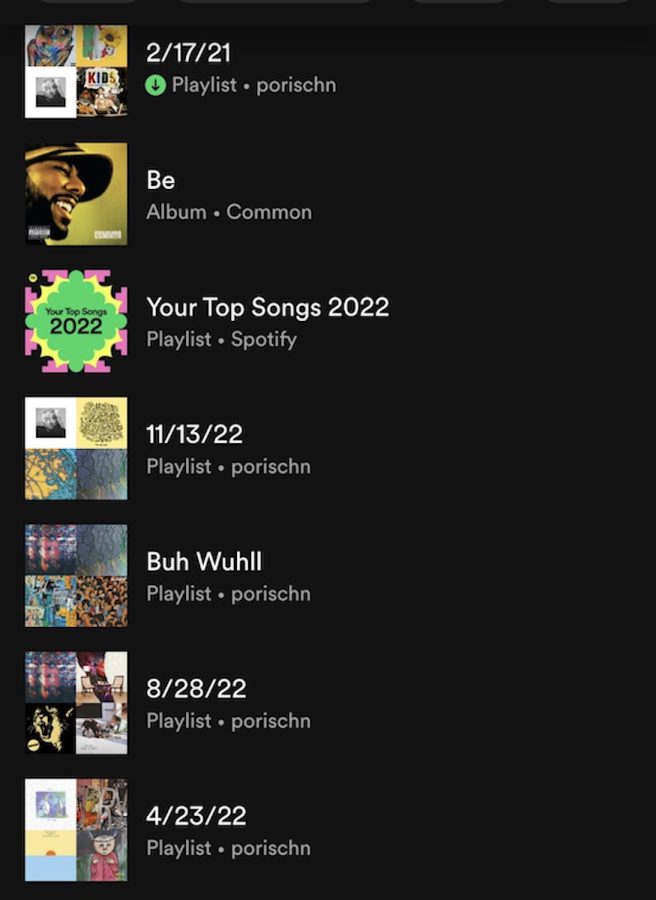The wonderful world of playlist titles
From vibes and circumstances to memes and memories
Photo by Nick Porisch
I’m here to talk about an underappreciated, but vital point in the playlist creation process — the title.
I first downloaded Spotify in eighth grade, and my spritely 13-year-old self instantly fell in love with the limitless music options.
But how can one possibly categorize these endless songs? How could I make my favorites easily accessible?
I found the answer in Spotify’s “playlist” tab, where users can make digital mixtapes of their favorite tunes. On that fateful spring day during the Obama administration, I made my first playlist.
“Awesome Songs” is a banger playlist featuring Weezer, Green Day, “All Star” by Smash Mouth and at least one song from the “Chicken Little” soundtrack. I can’t say I revisit it very often these days.
Since then, though, I’ve made well over 100 playlists on Spotify. Some feature as few as two or three songs, and the longest caps out at well over 60 hours of music. I’m not here to talk about the content of these playlists, though.
I’m here to talk about an underappreciated, but vital point in the playlist creation process — the title.
It’s pretty commonly understood that the music a person listens to says a great amount about who they are. By extension, playlists are personal catalogs of someone’s music taste.
However, I think the titles someone chooses for their playlists say a lot, too.
Some people organize their music by genre or vibe, and their playlists might have simple titles like “rap” or “gym hype” or “happy.” I don’t think anyone with a music streaming service can deny having a playlist named something like “sad vibes.”
That’s a little boring, though, and not very personal.
Spotify has an interesting social media aspect to its service, where you can “follow” your friends and see their playlists and recent listening.
Scrolling through some of my friends’ playlists, I see things like “95 in a school zone,” “snow castle” and “dino nuggets.”
Looking at the playlists’ contents, I can’t find any connection between these strange titles and the seemingly random songs beneath them.
That’s the cool thing, though. I’m sure that to my friends who made these apparently nonsensical playlists, those titles probably mean a lot.
Whether the names meant anything at the outset or were nothing but in-jokes, I have a feeling that listening to those playlists inevitably tied those titles to the feelings the songs gave them and the experiences they had while listening.
“Dino nuggets” might have started as a random joke when my friend couldn’t think of a title, but over time it might remind them of late-night summer drives, a class they spent countless nights studying for or a fondly remembered ex.
I’ve seen playlists organized by color, artist or the setting they’re meant to be played in. Again, though, the beauty of it all is that “kegger jams” or “orange” might hold more meaning to the people who listen to them than I could ever imagine.
As for me, I’ve gone through a few styles of playlist titles. Middle school me was a big fan of unironically stupid names because I was an unironically stupid middle schooler at the time.
Later, I went through a phase where most of my playlists’ names were just random sequences of letters, like “durbgf,” or things like that.
Since I started college, though, I usually just name my playlists after the date I made them.
Sometimes my playlists are designed around a vibe or a genre, but usually, they’re just a collection of new songs I’ve found or old songs I was recently reminded of. Frequently, I’ll hear a song in public, add it to my most recently created playlist and then never listen to it again.
What this essentially does is turn the “playlist” tab on Spotify for me into a musical diary.
Though just “12/16/21” doesn’t really recall many memories for me, if I click on that playlist and see songs like “The Recluse” by Cursive, “BS” by Still Woozy or “White Dress” by Ayo River I’m immediately transported back to that time, place and headspace.
My system isn’t perfect. I don’t revisit 90 percent of the playlists I’ve made, and I objectively have way too many, but it can be a really cool way to see how my music habits have grown and changed, and by extension how I have grown and changed, too.
Porisch can be found at porischn7213@uwec.edu.

Nick Porisch is a third-year English student, and this is his fourth semester at The Spectator. Most of the time you can find him just sitting around someplace, potentially writing but usually just sitting. On the rare occasion he’s not sitting around, he might be rock climbing or running. But most likely he’s just sitting somewhere.


